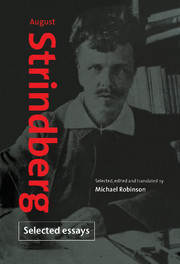Book contents
- Frontmatter
- Contents
- Notes on the text
- Introduction
- from Vivisections (1887)
- ‘On Modern Drama and Modern Theatre’ (1889)
- from Vivisections II (1894)
- ‘I’
- ‘The Making of an Aspasia’
- ‘Nemesis Divina (Cont.)’
- ‘The New Arts! or The Role of Chance in Artistic Creation’
- ‘Whence We Have Come’
- ‘Character a Role?’
- ‘Césarine’ (1894)
- ‘Deranged Sensations’ (1894)
- ‘In the Cemetery’ (1896)
- from Jardin des Plantes (1896)
- ‘On the Action of Light in Photography’ (1896)
- ‘A Glance into Space’ (1896)
- ‘Edvard Munch's Exhibition’ (1896)
- ‘The Synthesis of Gold’ (1896)
- ‘Contemporary Gold-Making’ (1896)
- ‘The Sunflower’ (1896)
- ‘The Mysticism of World History’ (1903)
- ‘August Strindberg on Himself’ (1909)
- Notes and commentary
- Index
‘The Making of an Aspasia’
Published online by Cambridge University Press: 18 December 2009
- Frontmatter
- Contents
- Notes on the text
- Introduction
- from Vivisections (1887)
- ‘On Modern Drama and Modern Theatre’ (1889)
- from Vivisections II (1894)
- ‘I’
- ‘The Making of an Aspasia’
- ‘Nemesis Divina (Cont.)’
- ‘The New Arts! or The Role of Chance in Artistic Creation’
- ‘Whence We Have Come’
- ‘Character a Role?’
- ‘Césarine’ (1894)
- ‘Deranged Sensations’ (1894)
- ‘In the Cemetery’ (1896)
- from Jardin des Plantes (1896)
- ‘On the Action of Light in Photography’ (1896)
- ‘A Glance into Space’ (1896)
- ‘Edvard Munch's Exhibition’ (1896)
- ‘The Synthesis of Gold’ (1896)
- ‘Contemporary Gold-Making’ (1896)
- ‘The Sunflower’ (1896)
- ‘The Mysticism of World History’ (1903)
- ‘August Strindberg on Himself’ (1909)
- Notes and commentary
- Index
Summary
Per Andersson, Denmark's most famous author, who has been singlehandedly responsible for an epoch in his country's literature, was summoned to Munich to inject some life into Bavarian poetry, which had fallen into decay since the Franco-German war.
Andersson had a disciple, a fellow-countryman called Hanson, who had been living in Bavaria for four years, with a wife who had been striving to become the Joan of Arc of Young Bavaria, though without success since a niggardly nature had denied her the exterior of a literary lady. Infuriated by this miscalculation, she sent for the great Andersson, allotting him the role of bird-lime in which the young chicks would fasten.
Andersson arrives and settles down near his friends in Munich. An extremely close circle had grown up around Hanson, enticed there by his moonlight, which was borrowed from Andersson's sun. With the circle now confronted by Hanson's archetype the latter fades, like a copy, with all the ensuing jealousy and intrigues, and ends with a bang and the break-up of the circle, which is swept off to a wine seller's, where Andersson establishes himself as a habitué. Here he spreads the seeds of his mature intellect, taken from an immense stock of observations on life which he knows how to exploit through his acknowledged faculty of combination.
He functions as a leaven, and his seeds begin to grow in these young minds, prepared in advance by his disciple Hanson. They proclaim him master and father, and call themselves his apostles.
- Type
- Chapter
- Information
- August Strindberg: Selected Essays , pp. 92 - 96Publisher: Cambridge University PressPrint publication year: 1996



